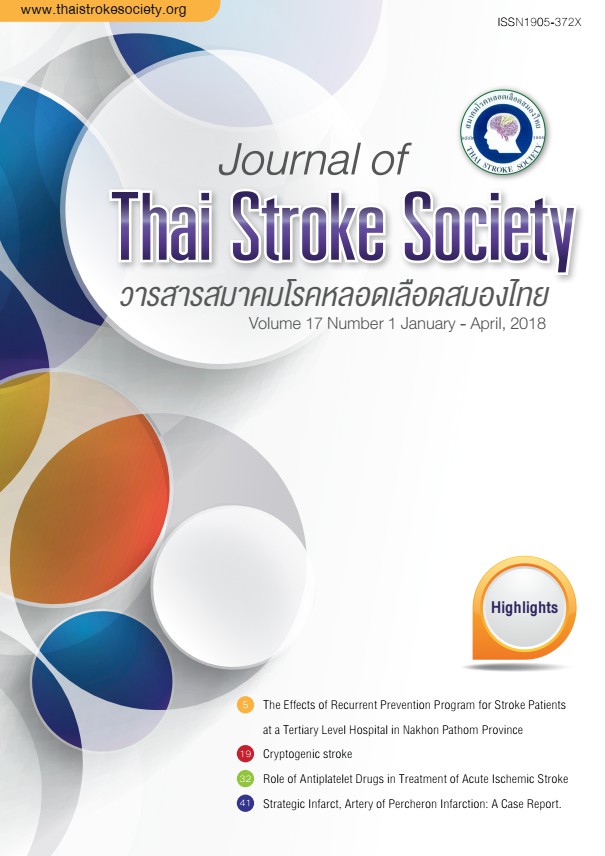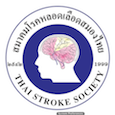Strategic Infarct, Artery of Percheron Infarction: A Case Report.
Keywords:
artery of Percheron, strategic infarct, amnesiaAbstract
A 78-year-old Thai woman presented with memory loss, confusion, and psychomotor retardation which gradually worsened over 2 days. She denied fever, weakness, numbness and visual or auditory hallucination, and was alert and oriented to time, place and person. Upon thorough neurological examination, her results were normal except for MoCA 27/30. Laboratory work-up which included complete blood count and blood chemistry were within normal limits. An MRI brain showed restricted DWI at bilateral paramedian thalami with a diagnosis of artery of Percheron infarction. Although the patient did not present with the classic triads of artery of Percheron infarction, i.e. alteration of consciousness, neuropsychological abnormalities, and vertical gaze paresis, physicians were finally able to conclude on a definitive diagnosis with a thorough physical examination to help indicate appropriate investigation and diagnostic measures. In summary, it is encouraged to perform complete a neurological examination including neuropsychological tests in every patient who presents with neuropsychological abnormalities.
References
Matheus MG, Castillo M. Imaging of acute bilateral paramedian thalamic and mesencephalic infarcts. AJNR Am J Neuroradiol. 2003;24(10):2005-8.
Monet P, Garcia PY, Saliou G, Spagnolo S, Desblache J, Franc J, et al. [Bithalamic infarct: is there an evocative aspect? Radioclinical study]. Rev Neurol (Paris). 2009;165(2):178-84.
Lin G, Zhang X, Hu B, Zou M, Chen S, Gong Y, et al. Paramedian Thalamic Ischemic Infarction: A Retrospective Clinical Observation. Eur Neurol. 2017;77(3-4):
197-200.
Kostanian V, Cramer SC. Artery of Percheron thrombolysis. AJNR Am J Neuroradiol. 2007;28(5):870-1.
Rodriguez EG, Lee JA. Bilateral thalamic infarcts due to occlusion of the Artery of Percheron and discussion of the differential diagnosis of bilateral thalamic lesions. J Radiol Case Rep. 2013;7(7):7-14.
Lazzaro NA, Wright B, Castillo M, Fischbein NJ, Glastonbury CM, Hildenbrand PG, et al. Artery of percheron infarction: imaging patterns and clinical spectrum. AJNR Am J Neuroradiol. 2010;31(7):1283-9.
Chatterjee S, Thomas B, Kesavadas C, Kapilamoorthy TR. Susceptibility-weighted imaging in differentiating bilateral medial thalamic venous and arterial infarcts. Neurol India. 2010;58(4):615-7.
A r a u z A , P a t i ñ o - R o d r í g u e z H M , Vargas-González JC, Arguelles-Morales N, Silos H, Ruiz-Franco A, et al. Clinical spectrum of artery of Percheron infarct: clinical-radiological correlations. J Stroke Cerebrovasc Dis. 2014;23(5):1083-8.
Downloads
Published
How to Cite
Issue
Section
License
ข้อความภายในบทความที่ตีพิมพ์ในวารสารสมาคมโรคหลอดเลือดสมองไทยเล่มนี้ ตลอดจนความรับผิดชอบด้านเนื้อหาและการตรวจร่างบทความเป็นของผู้นิพนธ์ ไม่เกี่ยวข้องกับกองบรรณาธิการแต่อย่างใด การนำเนื้อหา ข้อความหรือข้อคิดเห็นของบทความไปเผยแพร่ ต้องได้รับอนุญาตจากกองบรรณาธิการอย่างเป็นลายลักษณ์อักษร ผลงานที่ได้รับการตีพิมพ์ในวารสารเล่มนี้ถือเป็นลิขสิทธิ์ของวารสาร





